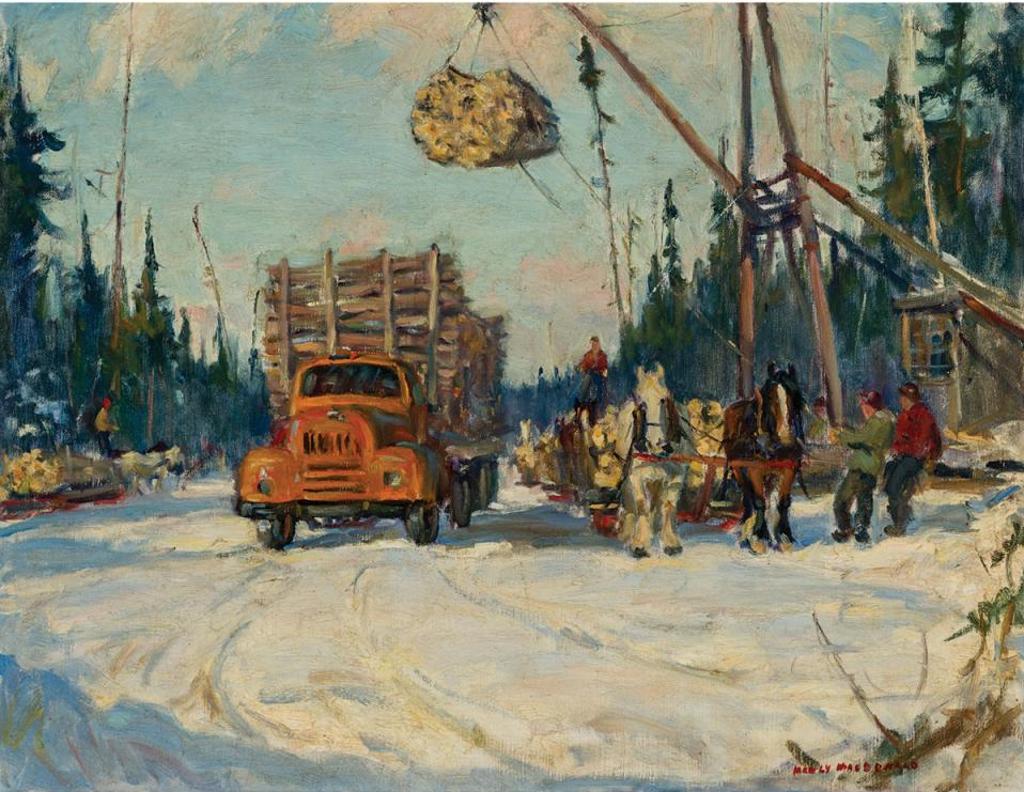
Loading The Logs
50.8 cms x 66 cms (20 ins x 26 ins)
Signed
Lot offered for sale by Waddington's, Toronto at the auction event "Canadian Fine Art Auction" held on Mon, May 28, 2018.
Lot 13
Lot 13
Estimate: CAD $5,000 - $7,000
Realised: CAD $10,200
Realised: CAD $10,200
Lot description - from the online catalogue*
Provenance:
Abitibi Bowater, Quebec
Private Collection, Ontario
Notes:
Traditionally, logging is a difficult and often dangerous occupation. During the early years of settlement in Ontario, logging served a dual purpose of clearing the land for farming and providing a source of building materials, fuel and income. In Prince Edward County, where Manly MacDonald (1889-1971) would likely have painted this scene, the logging industry had been active since the turn of the nineteenth century. Logging in the County focused mostly on the harvest of maple and pine done during the winter months by farmers who were not occupied by their primary occupation. In 1808, the first sawmill was built in Milford and by 1840 there were over 30 such operations. By the time this work was executed (probably in the mid-1950s), mechanization had begun to take over some of the more laborious aspects of foresting.
Demand for lumber and paper products was high after the second World War. The fruit growing for which the mild climate of the County is known also required the production of wooden crates and barrels to transport produce to market. Even today traces of the foresting industry remain.
While horses began to be replaced by tractors, the horse and their sled were still used in the thicker woods at least to haul harvests out to the forest's edge to meet railway lines, or later as seen here, to meet awaiting trucks. The truck depicted in this painting is probably an International Harvester, with its distinct grill and signature paint job. MacDonald charmingly depicts a harmonious fusion of tradition and innovation. It is interesting to consider that this work was painted during a period when the Toronto art world itself was struggling with traditional versus modernist approaches to art making, a polarization that the artist would undoubtedly have been aware of.
Abitibi Bowater, Quebec
Private Collection, Ontario
Notes:
Traditionally, logging is a difficult and often dangerous occupation. During the early years of settlement in Ontario, logging served a dual purpose of clearing the land for farming and providing a source of building materials, fuel and income. In Prince Edward County, where Manly MacDonald (1889-1971) would likely have painted this scene, the logging industry had been active since the turn of the nineteenth century. Logging in the County focused mostly on the harvest of maple and pine done during the winter months by farmers who were not occupied by their primary occupation. In 1808, the first sawmill was built in Milford and by 1840 there were over 30 such operations. By the time this work was executed (probably in the mid-1950s), mechanization had begun to take over some of the more laborious aspects of foresting.
Demand for lumber and paper products was high after the second World War. The fruit growing for which the mild climate of the County is known also required the production of wooden crates and barrels to transport produce to market. Even today traces of the foresting industry remain.
While horses began to be replaced by tractors, the horse and their sled were still used in the thicker woods at least to haul harvests out to the forest's edge to meet railway lines, or later as seen here, to meet awaiting trucks. The truck depicted in this painting is probably an International Harvester, with its distinct grill and signature paint job. MacDonald charmingly depicts a harmonious fusion of tradition and innovation. It is interesting to consider that this work was painted during a period when the Toronto art world itself was struggling with traditional versus modernist approaches to art making, a polarization that the artist would undoubtedly have been aware of.
Most realised prices include the Buyer's Premium of 18-25%, but not the HST/GST Tax.
(*) Text and/or Image might be subject matter of Copyright. Check with Waddington's auction house for permission to use.
(*) Text and/or Image might be subject matter of Copyright. Check with Waddington's auction house for permission to use.